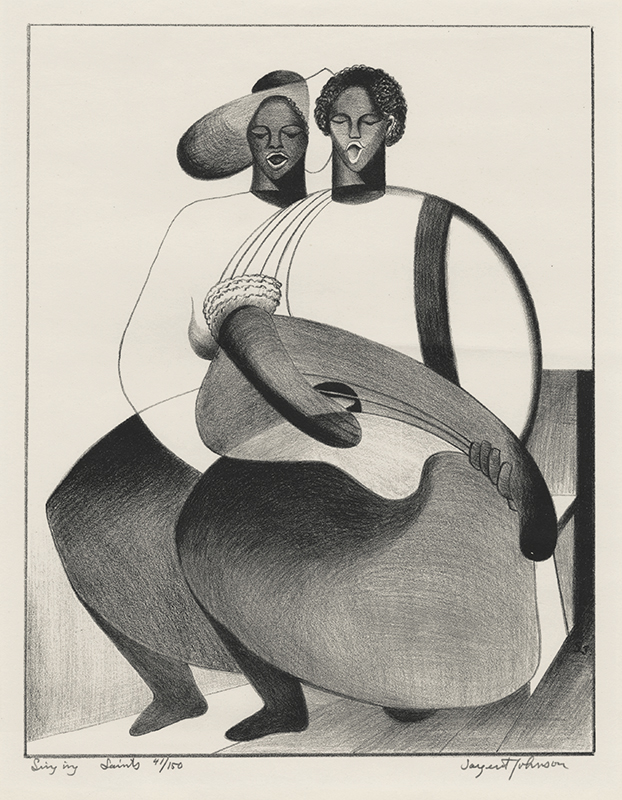Singing Saints is a lithograph created in 1940 by American artist Sargent Claude Johnson. It is pencil signed, titled and editioned 41/150. Singing Saints was published by the San Francisco Chronicle in the Spring of 1940 as part of their “Contemporary Graphics” series. It was presented in the Sunday Chronicle on 17 March 1940 as part of the second series of prints. Singing Saints was printed by Ray Bertrand on ivory, wove Warren’s Oldestyle paper and the image measures 12 x 9-1/4 inches.
In 1940, the San Francisco Chronicle devised a "plan to bring western art to the western public" by presenting “Contemporary Graphics” to its readers. The series launched on Sunday, 10 March 1940, and five prints were featured on consecutive Sundays. The artists included Herman Volz, George Gaethke, Ray Bertrand, Rueben Kadish, Arthur Murphy, Glen Wessels, Sargent Johnson, A. Ray Burrell, Beckford Young, Theodore Polos, Dong Kingman, Shirley Staschen, Clay Spohn, Edgar Dorsey Taylor, George Harris, Otis Oldfield, Benjamin Cunningham, H. Mallette Dean, John Haley, and Erle Loran.
Sargent Johnson worked in wood, copper, terra-cotta, cast stone, and black clay. By his own account, Johnson was concerned with “the pure American Negro,…aiming to show the natural beauty and dignity in that characteristic lip and that characteristic hair, bearing, and manner; and I wish to show that beauty not so much to the white man as to the Negro himself.”
Johnson returned to the theme and imagery of Singing Saints in 1967 when he painted a tempera on enamel, which he also entitled Singing Saints.
Sargent Claude Johnson (1887-1967), sculptor, ceramist, printmaker and teacher, was born on 7 October 1887 in Boston, Massachusetts. He was the third of six children born to Anderson Johnson of Swedish ancestry and Lizzie Johnson of African American and Cherokee ancestry. After the second of his parents died in 1902, Sargent was sent to live with his maternal grandparents before being placed in an orphanage in Worcester, Massachusetts.
His early studies were at the Worcester Art School in his home state. In 1915, Johnson traveled to San Francisco to attend the Panama Pacific International Exposition and decided to remain in California. He enrolled at the Arthur W. Best Art School and continued his studies at the California School of Fine Arts where he was a pupil of Ralph Stackpole and Beniamino Bufano. During the 1930s, Johnson served as a supervisor for the Federal Art Project. He created a number of lithographs under the FAP but some of his most important works during this time were Sea Form Marquee frieze of incised green slate on the exterior of the building and the mosaic murals on a promenade deck of the Aquatic Park Bathhouse (now the Maritime Museum) in San Francisco. Johnson lived for a time in Berkeley and taught at Mills College until 1948.
Johnson exhibited at the San Francisco Art Association Annuals, the Harmon Foundation National Exhibitions for black artists, the San Francisco Museum of Art, the Albany Institute of History and Art, as well as at the 1939 Golden Gate International Exposition and New York World’s Fair. Although he created in various media, his subjects centered upon the African American. Johnson is considered one the stellar artists of the Harlem Renaissance and he received the Harmon Foundation award for distinguished achievement among African Americans for the Fine Arts three times.
The work of Sargent Johnson is represented in the collections of the University of Michigan Museum of Art, Ann Arbor; the Baltimore Museum of Art; the Museum of Fine Arts, Boston; the Cleveland Museum of Art; the Detroit Institute of Arts Museum; the Westmoreland Museum of American Art, Greensburg; the Los Angeles County Museum of Art; the Metropolitan Museum of Art, New York; the New Orleans Museum of Art; the Newark Museum of Art; the Oakland Museum of California; the Philadelphia Museum of Art; the Portland Art Museum, Oregon; the Saint Louis Art Museum; San Diego Museum; the Fine Arts Museums of San Francisco; the Huntington Library, San Marino; the National Gallery of Art and the Smithsonian American Art Museum, Washington, D.C.
Sargent Claude Johnson died in San Francisco on 10 October 1967.



